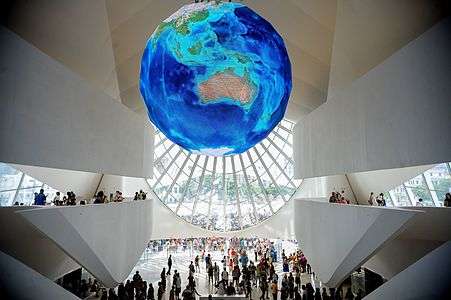Museum of Tomorrow
The Museum of Tomorrow (Portuguese: Museu do Amanhã) is a science museum in the city of Rio de Janeiro, Brazil. It was designed by Spanish neofuturistic architect Santiago Calatrava, and built next to the waterfront at Pier Maua. Its construction was supported by the Roberto Marinho Foundation and cost approximately 230 million reais. The building was opened on December 17, 2015, with President Dilma Rousseff in attendance.[1]
| Museu do Amanhã | |
| Established | 17 December 2015 |
|---|---|
| Location | Brazil |
| Area | 15,000 m2 (160,000 sq ft) |
| Architect | Santiago Calatrava |
| Website | museudoamanha |
Exhibitions
The main exhibition takes visitors through five main areas: Cosmos, Earth, Anthropocene, Tomorrow, and Us via a number of experiments and experiences. This intricate yet captivating museum mixes science with an innovative design to focus on sustainable cities and an ecological world.[1]
The museum was part of the city's port area renewal for the 2016 Summer Olympics.[2]
Criticism
As the Museu do Amanhã progressed, the funding for traditional museums continued to be cut by the government of Michel Temer (2016-2018), after the impeachment of President elected Dilma Rousseff. The National Museum and its internationally important collections were neglected, the building becoming unsafe electrically, and in September 2018 it was completely destroyed by fire, with firefighters complaining that the lack of water pressure prevented them from fighting the fire effectively.The Deputy Director of the National Museum, Luiz Fernando Dias Daniel, said that government neglect had caused the fire.[3]
Gallery
See also
References
- "Museum of Tomorrow: a captivating invitation to imagine a sustainable world". The Guardian. 17 December 2015. Retrieved 21 December 2015.
- "Rio's flashy new Museum of Tomorrow overlooks a big problem of today". Washington Post. Retrieved 2018-08-18.
- "Fire at Brazil National Museum engulfs 200-year-old building". Deutsche Welle. 2 September 2018. Archived from the original on 3 September 2018. Retrieved 3 September 2018.


